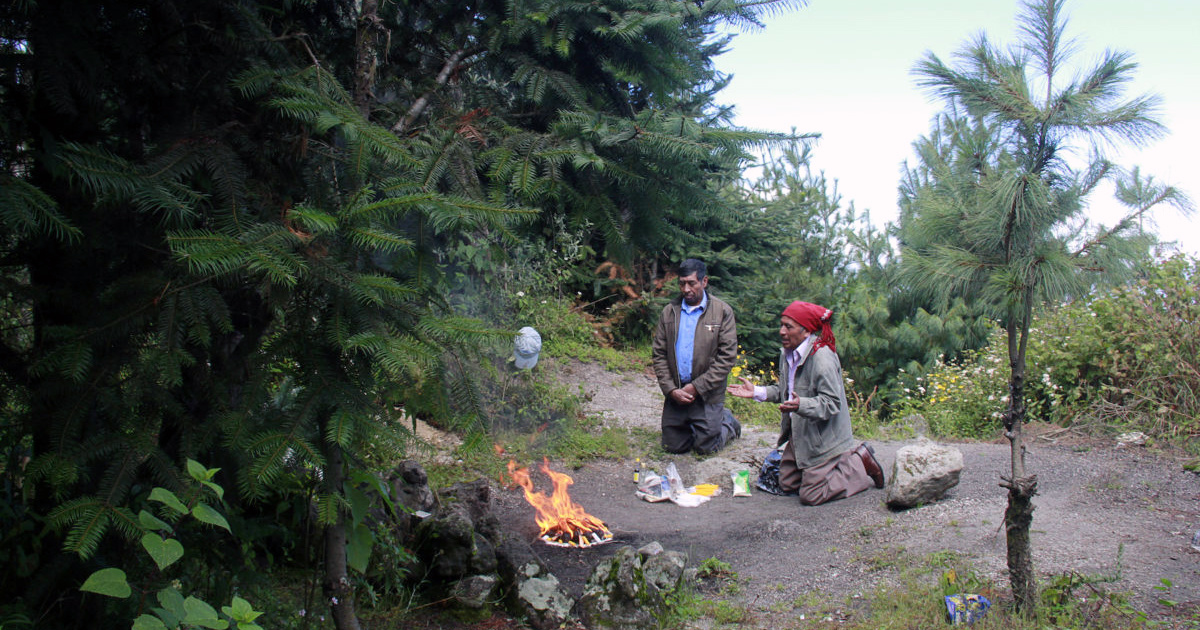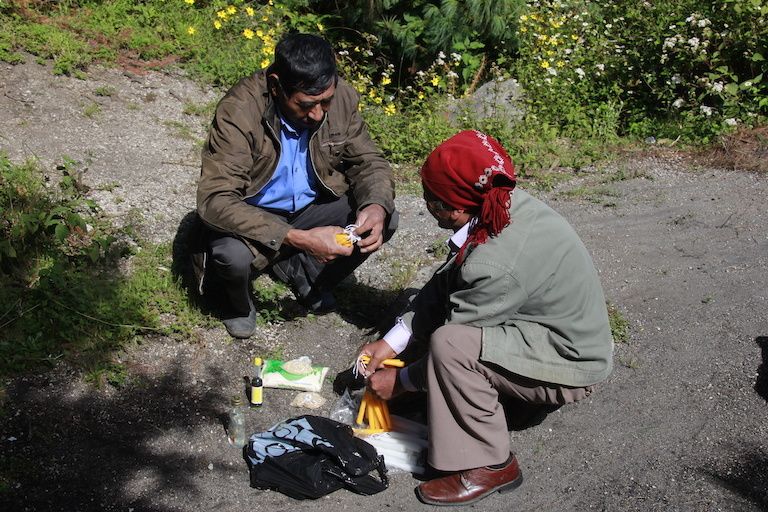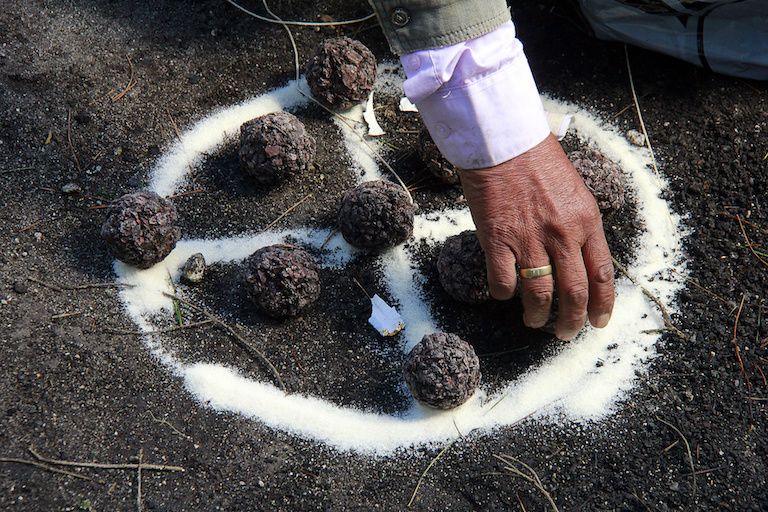
Ancient Spirituality Guides a Maya Town’s Conservation Efforts

By Jorge Rodríguez
It was Thursday, Nov. 8, but the Mayan calendar marked the day as Wukub’ Q’anil, or 7 Rabbit, a good day to ask for the rebirth of sterile lands and the fertility of all living beings.
Rumualdo López, a Maya priest and spiritual guide, was prepared to hike up to the top of Siete Orejas, a mountain sacred to the Maya Mam of Concepción Chiquirichapa, a town of roughly 18,000 in western Guatemala, to perform a fire ceremony. The purpose was to connect with the energies of the mountain and ask for wisdom and the blessing of the Creator, the Ajaw as the Maya Mam call it.
“Nowadays there are many people who prefer to connect with the Ajaw through other rites, such as Christians or Catholics,” López had said the day before the ceremony, checking the Mayan calendar. “The important thing is for people to recognize the energy that surrounds us and to connect with it, no matter what type of beliefs they have.”
As has been done for thousands of years, Mayan traditions and knowledge are still passed on by word of mouth. Priests or Ajq’ij, which means “counter of days” in the Maya K’iche language, rely on the Mayan calendar, as an astrological chart, to understand the energies of each day and determine when to perform certain ceremonies and what to ask of the Ajaw.
There is no specific time at which ceremonies should be performed. Sometimes the first light of dawn is when guides give thanks to the Ajaw and all the living energies of the universe. On this occasion, however, López, along with Marcelino Aguilar, the head of Concepción’s Department of Protected Areas (DAP, by its Spanish initials), decided to set out from the town center for the mountain at 8:00 in the morning.
Like López, Aguilar believes in the knowledge of their ancestors. “We all depend on each other to survive,” he said. That is why he has dedicated his life to protecting the environment and educating the people of Concepción to value and respect the forest.
A sign inside Concepción Chiquirichapa’s Kum Kum Wutz park on Siete Orejas mountain reads “Without the environment there is no future.” Jorge Rodríguez / Mongabay
The Way to the Mountaintop
To reach the top of Siete Orejas takes about 45 minutes by car, one and a half hours by foot. While driving his pickup truck, a Maya Mam radio station playing in the background, Aguilar talked about the community’s work over the past four decades to reforest and protect its section of the mountain’s cloud forest. Since the 2000s the community got the government to designate a 1,200-hectare (4.6-square-mile) park on Siete Orejas as a protected area; regulated the extraction of organic matter, wood and other natural resources there; created the DAP, a municipal office dedicated to the protected area’s management; and started several environmental education and sustainable economic development programs.
While Aguilar spoke, López listened. Sometimes, he would smile or add some detail to the story: “When I was young, this [forest] used to have fewer trees than it has right now.” But most of the time his face was serious, as if he were feeding on energy from the forest that rose above the dirt road leading up the mountain.
Rumualdo López, a Maya spiritual guide and one of Concepción Chiquirichapa’s elected municipal councilmembers.Jorge Rodríguez / Mongabay
To be an Ajq’ij is a great honor for anyone who believes in the ancient traditions. Ajq’ijes are believed to serve as the connection between the spiritual and material worlds. They are meant to seek the truth of all things and constantly study the environment and the signals that nature manifests, like the way the wind blows, the shape of the clouds on a rainy morning or the song of certain birds.
Siete Orejas is important because of the energy that lives there, López said. “As Maya we believe in the 13 energies of the nahuales,” he said, referring to the connections, represented by different animals, between the natural and spiritual worlds. According to the Maya, every living thing has a nahual, including mountain peaks like Siete Orejas’s.
Mountain summits are special places in Mayan spirituality, because the energy flow there is believed to be stronger than in other places. In spots where they believe the mountain’s energy dwells, they make altars to perform rituals. There are 22 on Siete Orejas.
Aguilar parked the truck at the entrance to a camping area inside the park and went off briefly to the registration booth to check in with the municipal tour guides working there. López stretched his legs and grabbed the bag of materials for the ceremony from inside the truck.
During the final 25-minute hike to the top of the mountain, he carried in one hand a black plastic bag with candles of various colors, sugar, a ceremonial incense called pom, white rum, water steeped with flowers called florid water, and resin from the ocote tree (Pinus montezumae). In the other he carried a wooden rod called a Tz’ite that is considered the Ajq’ij’s spiritual partner and believed to allow him or her to read energies that human senses cannot detect.
At the top, López asked Aguilar to find him some herbs for the ritual. The altar was a semicircle of lichen-crusted rocks in the bare gravel, decorated with a shoulder-high wooden Catholic cross. Large pines and pinabete (Abies guatemalensis) trees surrounded it.
Marcelino Aguilar, head of Concepción Chiquirichapa’s Department of Protected Areas, and Rumualdo López prepare materials for a Maya Mam fire ceremony on Siete Orejas. Jorge Rodríguez / Mongabay
Since the colonization of Guatemala in the 16th century, Mayan spirituality has incorporated some Catholic beliefs and imagery, like the cross. “Catholic believers have a different interpretation of the cross, because it is unbalanced,” López said. “For us the sides of the cross are the same length, since they represent our origin, our destiny and the energies that govern our path.”
He cleaned the altar of leaves and debris because everything that burns in the fire has a specific meaning. Then, in its center he drew a Mayan cross inside a circle with the sugar: “to sweeten the bitterness and allow us to read in the fire.”
Inside the circle, he placed the pom balls, made from the resin of the copal tree (Protium copal). They are one of the most sacred offerings used in rituals, along with the ocote resin. With the florid water he cleaned and blessed the place and those attending the ceremony. After a silent prayer, he started the fire and began the ritual.
Rumualdo López sets a balls of incense called pom inside a Mayan cross of sugar in preparation for a fire ceremony. Jorge Rodríguez / Mongabay
The Favor of the Ajaw
As the fire began to rise, López spoke in his native language, thanking the Ajaw for the blessings it provides through Mother Nature. He walked in circles to symbolize the cycles of time as he asked for the well-being of the other Ajq’ij, of his people and of all living things in the universe.
The Maya understand the dance that fire performs at certain times as a manifestation of the energetic connection that exists during ceremonies. “The nahuales tell us if something is wrong. With the candles, we make requests that are then burned and become part of everything that surrounds us,” López said.
For more than 40 minutes, López’s prayers and thanks rose with the smoke of the materials he brought. To further purify the act, he poured the rum over the fire, over the rocks of the altar and over the people present at the ceremony.
“This is a day to ask for understanding, for good work and to remove pests from crops,” he said, referring to Wukub’ Q’anil. At the end of the ceremony, he collected the empty bags and containers and raised a final thanks to the sky, kissing the ground several times.
Ancient Beliefs for Modern Times
The day before the ritual, at his office in Concepción’s municipal building, López, who is an elected member of the municipal council in addition to being an Ajq’ij, had lamented how urban growth and the culture of consumerism were taking over life in Concepción, and how this directly affected the natural environment and the spirit of the community.
“Now we see disconnection [between people] and their surroundings. We have seen how the clouds have decreased and the wind no longer blows as it did before,” he’d said. “Therefore, we are looking for new sacred places, because we are in a time when humanity needs to be redirected toward the spiritual, above the material.”
During the ride back to town from Siete Orejas, Aguilar recognized that the spiritual connection with the mountain and a profound respect toward the natural word, knowledge inherited from their grandparents, had propelled him and his supporters to double their efforts to conserve the local forests.
“We are getting the people to understand that everything is connected, that we have to learn how to coexist with the wildlife that inhabits the woods,” he said. “Though there are some who oppose what we do, or simply don’t care, we are certain that the majority of the people of Concepción are grateful for the efforts we make to ensure the survival of our mountain.”
Pine trees in Kum Kum Wutz park on Siete Orejas. Over the course of four decades, residents of Concepción Chiquirichapa have reforested the area, turning it into a green beacon. Jorge Rodríguez / Mongabay
Reposted with permission from our media associate Mongabay.

 233k
233k  41k
41k  Subscribe
Subscribe 




